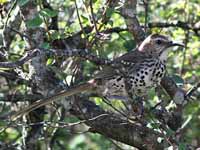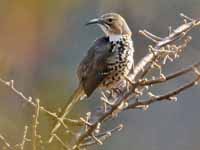BIRDS of THE WORLD - An Online Bird Book
Order Passeriformes Family Mimidae
Mimics - Mockingbirds and Allies
Order Passeriformes Family Mimidae
The members of family Mimidae are mimics. They are the catbirds, mockingbirds, thrashers. Many mimids have a rather thrush-like pattern: brown above, pale with dark streaks or spots below. They tend to have longer tails than thrushes. They have long, strong legs with which many species hop through undergrowth searching for food. Mimids build somewhat messy, bulky twig nests in dense growth, usually no more than 2 meters up.
Genus Allenia - 1 species
Thrasher,_Scaly-breasted Allenia fusca Found: Caribbean Lesser Antilles
The Scaly-breasted Thrasher has pale underparts with scalloping; thin white wing-bars; short dark bill.


Genus Cinclocerthia
When excited, the tremblers flick their wings and their entire bodies in a trembling motion. The trembling results in reverberation when singing.
Trembler,_Brown Cinclocerthia ruficauda Found: Caribbean Lesser Antilles
The Brown Trembler has reddish-brown upperparts; more rufous on rump, wings, tail; buffy brown underparts; yellow eyes; blackish down-curved bill.

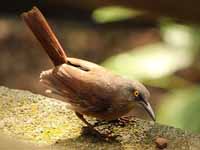
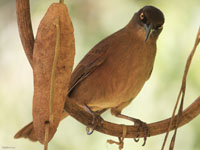
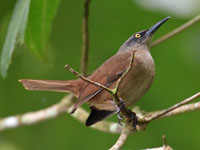
Trembler, Gray Cinclocerthia gutturalis Found: Martinique, Saint Lucia
The Gray Trembler has gray upperparts; pale underparts; dark mask.
Image by: 1) Joseph Smit 2) Marcel Holyoak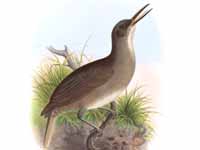

Genus Dumetella - 1 species
Catbird,_Gray Dumetella carolinensis Found: North America, Central America
The Gray Catbird has mainly lead-gray plumage; darker cap; black eyes, bill.
1) Juvenile



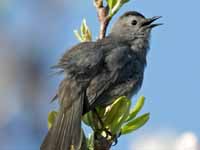



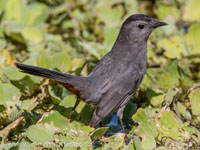
Genus Margarops - 1 species
Thrasher,_Pearly-eyed Margarops fuscatus Found: Puerto Rico, Virgin Islands, and neighborhood
The Pearly-eyed Thrasher has brown upperparts; brown breats; pale eyes, belly.
Image by: 1, 2) Dick Daniels - Puerto Rico 3) Dick - Puerto Rico 4) Dick on St John island, Virgin Islands 5, 6, 7) Dick on St John island, Virgin Islands
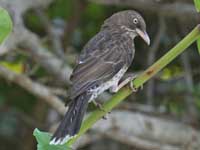


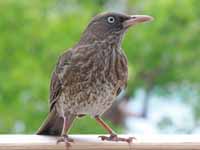

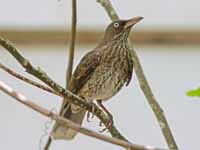
Genus Melanoptila - 1 species
Catbird_ Black Melanoptila glabrirostris Found: Mexico, Belize, Guatemala
The Black Catbird has glossy black plumage; black bill, legs; dark reddish eyes. It does not mimic other species.
Image by: 1) Steve Bachman 2) Amy McAndrews 3) dfaulder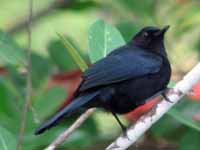


Genus Melanotis
Mockingbird, Blue Melanotis caerulescens Found: Mexico
The Blue Mockingbird has mainly dark blue plumage; with a dark mask across the face.
Image by: 1) Jerry Oldennettel north of Oaxaca, Mexico 2, 3) Pablo Leautaud
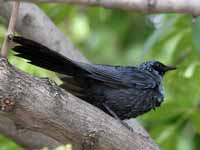

Mockingbird,_Blue-and-White Melanotis hypoleucus Found: El Salvador, Guatemala, Honduras, Mexico
The Blue-and-White Mockingbird has grayish-blue upperparts; black maks; white underparts; red eye.
Image by: 1) Amy McAndrews - Chiapas, Mexico 2) Jorge Montejo 3) - Mexico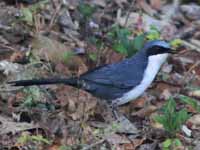


Genus Mimus
Mockingbird,_Bahama Mimus gundlachii Found: Bahamas, Cuba, Jamaica, Turks and Caicos Islands
The Bahama Mockingbird has brown upperparts; pale streaked underparts.
Similar to: Northern Mockingbird. Bahama Mockingbird has brown striped back; Northern Mockingbird has gray unstriped back.
Image by: 1, 2) Laura Gooch - Cuba 3) Dan IrizarrySimilar to: Northern Mockingbird. Bahama Mockingbird has brown striped back; Northern Mockingbird has gray unstriped back.



Mockingbird,_Brown-backed Mimus dorsalis Found: mainly in Bolivia, also Argentina, Chile
The Brown-backed Mockingbird has brown back, rump; dark in most of upper-tail; white on outer tail.
Image by: 1) d'Orbigny 2) Ron Knight - Argentina 3) - Argentina
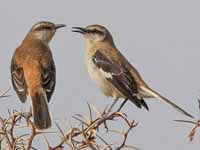

Mockingbird, Chalk-browed Mimus saturninus Found: South America
Image by: 1) Dario Niz 2 Dario Sanches - Brasil 3) Cláudio Timm - Brazil 4) Cristiano Crolle - Buenos Aires, Argentina


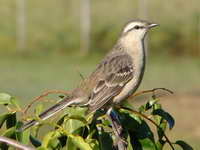

Mockingbird,_Chilean Mimus thenca Found: Chile
The Chilean Mockingbird has brown upperparts; pale underparts with some streaking on flanks; white supercilium.
Image by: 1) Alastair Rae 2) Flavio Camus 3) Pablo Contreras 4) Nick Athanas 5, 6, 7) Dick Daniels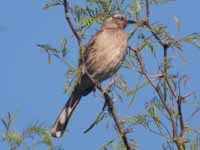

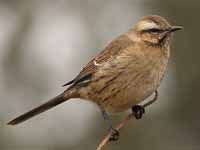
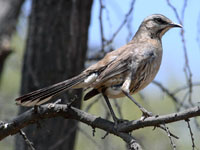
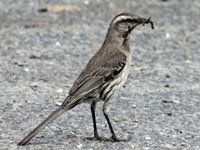
Mockingbird,_Floreana Mimus trifasciatus Found: near Floreana Island (Galapagos)
The Floreana Mockingbird is no longer found on Floreana due to cats and dogs. It is close to extinction.
Image by: 1) John Gould 2) Andy_Kraemer

Mockingbird, Galápagos Mimus parvulus Found: The Galapagos Islands
The Galapagos Mockingbird is the only mockingbird that is found on more than one Galapagos island.
Image by: 1, 2, 3)
Dick Daniels - Galapagos Islands 4) Mark Putney

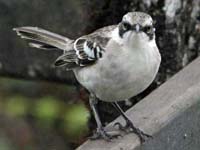

Mockingbird,_Hood also Espanola Mockingbird Mimus macdonaldi Found: Espanola Island, Galapagos
The Espanola Mockingbird has gray plumage; bold dark mask; dark lateral throat stripes. They are very bold, landing on hats and backpacks looking for food.
Image by: 1) Tim Ellis 2) James Preston 3) Benjamint444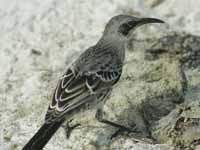

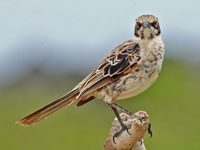
Mockingbird,_Long-tailed Mimus longicaudatus Found: Ecuador, Peru
The Long-tailed Mockingbird plumage is made up of gray, cappuccino, and dun coloured feathers. The outer tail feathers are broadly tipped white. Its face has been described as harlequin patterned.
Image by: 1, 2) - Ecuador, Peru 3,4, 5) Dick Daniels - Lima, Peru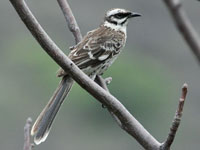

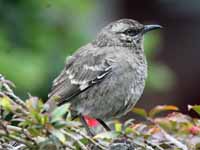
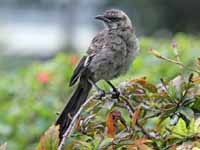

Mockingbird, Northern Mimus polyglottos Found: North America, Carribean
The Northern Mockingbird has gray to brown upperparts; pale underparts; white patches on wings visible in flight.
Similar to: Bahama Mockingbird. Bahama Mockingbird has has brown striped back; Northern Mockingbird has gray unstriped back.
Similar to: Loggerhead Shrike, Northern Shrike. Loggerhead Shrike, Northern Shrike have black eye-line; Northern Mockingbird has no eye-line.
Similar to: Phainopepla. Phainopepla does not closely resemble Cedar Waxwing except for its general shape.
Image by: 1) Ken Schenider - Florida 2, 3, 4, 5, 6) Dick Daniels - North Carolina 7) Dick - York, Maine 8) Dick - JamaicaSimilar to: Bahama Mockingbird. Bahama Mockingbird has has brown striped back; Northern Mockingbird has gray unstriped back.
Similar to: Loggerhead Shrike, Northern Shrike. Loggerhead Shrike, Northern Shrike have black eye-line; Northern Mockingbird has no eye-line.
Similar to: Phainopepla. Phainopepla does not closely resemble Cedar Waxwing except for its general shape.
1) Juvenile
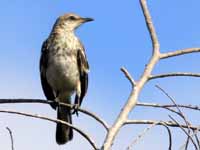

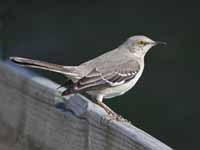


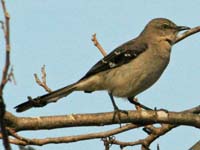

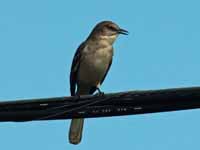
Mockingbird,_Patagonian Mimus patagonicus Found: Argentina, Chile
The Patagonia Mockingbird has gray plumage; darker wings; lighter and buffy flanks; white supercilium.
Image by: 1, 2) Nick Athanas - Argentiana 3) Nestor Galina 4) Charlie Westerinen - Argentina 5) Ron Knight 6) Lenaldo_Vigo
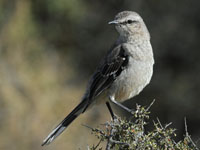
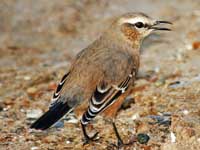
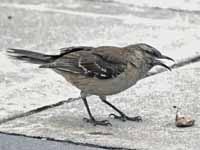
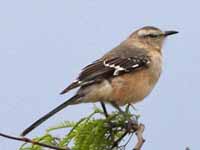

Mockingbird,_ San_Cristobal Mimus melanotis Found: San Cristobal, Galapagos
The San Cristobal Mockingbird is the only mockingbird species on San Cristobal.
Image by: 1) John Gould 2) Benjamint444 3) BRJ_Inc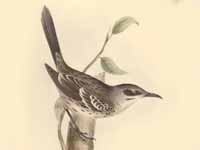


Mockingbird, Socorro Mimus graysoni Found: Socorro Island (Mexico)
The Socorro Mockingbird has mainly brown plumage;darker tail; lighter underparts; two narrow white wing-bars.
Image by: 1) Eveha 2) Amy McAndrews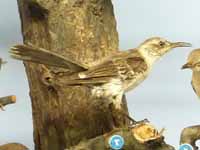

Mockingbird,_Tropical Mimus gilvus Found: Central and South America
The Tropical Mockingbird has gray upperparts, head; yellow eyes; pale supercilium; off-white underparts; 2 thin white wing-bars.
Image by: 1, 2) New Jersy Birds 3) Tom
Friedel (BirdPhotos.com) 4) Carlos_Henrique - Ecuador 5) Amado_Demesa - Mexico 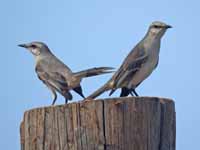
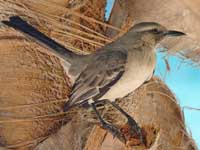



Mockingbird,_White-banded Mimus triurus Found: South America
The White-banded Mockingbird has grayish back; white supercilium; dark eye-line; outer thirds of tail white; inner third of tail black; very long wings (in proportion to body).
Image by: 1)elnudomolesto 2) Aldo_Giuzio - Argentina 3) Cláudio
Timm - Brazil 4) Carlos Henrique

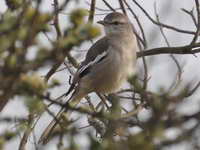

Genus Oreoscoptes - 1 species
Thrasher,_Sage Oreoscoptes montanus Found: North America
The Sage Thrasher has gray-brown upperparts; white underparts with dark streaks; straight relatively short bill; yellow eyes; long tail.
Image by: 1) Len Blumin - California 2) Alan D Wilson - New Mexico 3) Peter Massas - New Jersey 4) Wolfgang Wander - Wyoming 1) Juvenile 2, 3) Adult 4) Worn adult
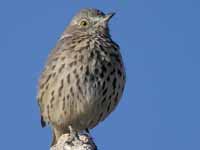
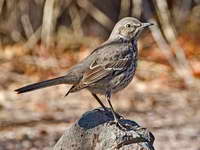
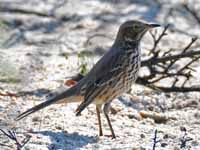
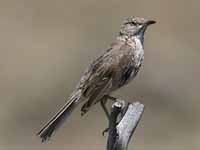
Genus Ramphocinclus - 1 species
Thrasher,_White-breasted Ramphocinclus brachyurus Found: Martinique and Saint Lucia (Lesser Antilles)
The White-breasted Thrasher has dark brown upperparts; white throat, breast; white with some brown belly.
Image by: 1) Frantz Delcroix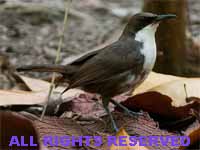
Genus Toxostoma
Most thrashers feed on ground dwelling insects. They rarely fly in the open, preferring to keep hidden in brush. They don't fly much thus their wings are short and rounded.
Thrasher,_Bendire's Toxostoma bendirei Found: southwest North America and northern Mexico
The Bendire's thrasher has gray plumage; slightly lighter on underparts; down-curved bill. It lives in brush-filled deserts and valleys and drylands of the south-western United States, mainly along the southern border that Arizona and New Mexico shares with Mexico.
Similar to: Curve-billed Thrasher. Curve-billed Thrasher has a longer and more curved bill than does Bendire's Thrasher. Curve-billed has faint round spots on breast, Bendire's has triangular spots.
Image by: 1) Charlie Westerinen - near Aguila, Arizona 2, 3) Jerry Oldenettel - California Similar to: Curve-billed Thrasher. Curve-billed Thrasher has a longer and more curved bill than does Bendire's Thrasher. Curve-billed has faint round spots on breast, Bendire's has triangular spots.
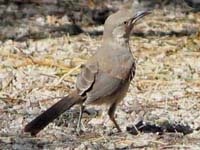

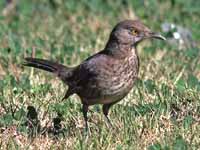
Ï
Thrasher,_Brown Toxostoma rufum Found: North America
The Brown Thrasher has brown upperparts; white throat; white underparts with dark streaks. It has a repertoire of over 1000 songs, perhaps the largest of any species.
Similar to: Long-billed Thrasher. Brown Thrasher is bright reddish-brown above with thin, dark streaks on its buffy underparts. Long-billed Thrasher is brown above with heavy black streaks its white underparts.
Image by: 1, 2, 4, 5, 6, 7) Dick Daniels in North Carolina 3) Andy_Morffew 8) Charlie_Westerinen - Virginia Similar to: Long-billed Thrasher. Brown Thrasher is bright reddish-brown above with thin, dark streaks on its buffy underparts. Long-billed Thrasher is brown above with heavy black streaks its white underparts.

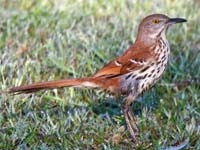
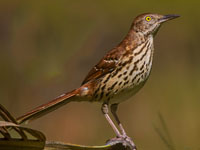


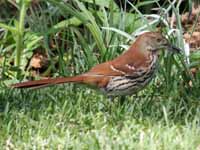


Thrasher,_California Toxostoma redivivum Found: California and Baja California
The California Thrasher has brown upperparts; buffy underparts and under-tail; dark cheek pattern; dark eyes (unlike most thrashers); faint dark eye-line.
Similar to: Crissal Thrasher. Crissal Thrasher has a longer bill and lighter iris than does the California Thrasher. California Thrasher has a dark eye-line.
Similar to: Le Conte's Thrasher. Le Conte's Thrasher is found in open desert areas while California Thrashers and Crissal Thrashers are secretive and and like brushy areas.
Image by: 1) Alan Vernon 2) Linda Tanner 3) Dick Daniels - Half Moon Bay, California 4) Len Blumin in San Benito County, California Similar to: Crissal Thrasher. Crissal Thrasher has a longer bill and lighter iris than does the California Thrasher. California Thrasher has a dark eye-line.
Similar to: Le Conte's Thrasher. Le Conte's Thrasher is found in open desert areas while California Thrashers and Crissal Thrashers are secretive and and like brushy areas.

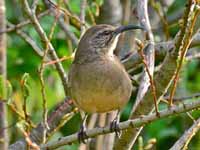

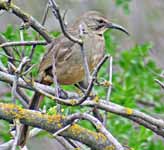
Thrasher,_Cozumel Toxostoma guttatum Found: island of Cozumel off Mexico mainland
The Cozumel Thrasher has brown upperparts; grau-brown lores, ear coverts; buffy-white underparts black teardrop shaped spots. It might be extinct.
Image by: 1) Chermundy 2) hbw.com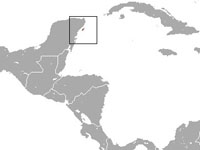

Thrasher,_Crissal Toxostoma crissale Found: Southwest North America
Similar to: California Thrasher. Crissal Thrasher has a longer bill and lighter iris than does the California Thrasher. California Thrasher has a dark eye-line.
Similar to: Le Conte's Thrasher. Le Conte's Thrasher is found in open desert areas while California Thrashers and Crissal Thrashers are secretive and and like brushy areas.
Image by: 1) John J. Mosesso 2) Jerry Oldenettel - New Mexico 3) J N Stuart - Nevada 4) Steven_Severinghaus - NevadaSimilar to: Le Conte's Thrasher. Le Conte's Thrasher is found in open desert areas while California Thrashers and Crissal Thrashers are secretive and and like brushy areas.



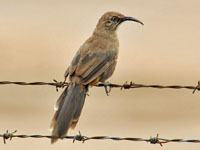
Thrasher,_Curve-billed Toxostoma curvirostre Found: North America
The Curve-billed Thrasher has gray upperparts; paler underparts; down-curved bill. Other thrashers have bills that are more curved, but they were not known when the Curve-billed Thrasher was named.
Similar to: Bendire's Thrasher. Curve-billed Thrasher has a longer and more curved bill than does Bendire's Thrasher. Curve-billed has faint round spots on breast, Bendire's has triangular spots.
Image by: 1) Dick Daniels - Desert Museum aviary in Tuscon, Arizona 2) Searchnet Media - Arizona 3) Alan D Wilson - New Mexico 4) Charlie Westerinen - Sampley, Arizona 5) Alan Vernon - Arizona 6) Jerry Oldenettel - New Mexico 7) Dick - Desert Botantical Gardens in Pheonix , ArizonaSimilar to: Bendire's Thrasher. Curve-billed Thrasher has a longer and more curved bill than does Bendire's Thrasher. Curve-billed has faint round spots on breast, Bendire's has triangular spots.
1) Juvenile

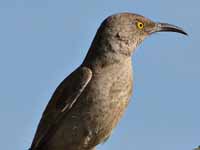

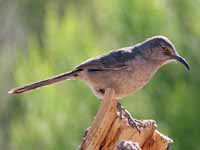

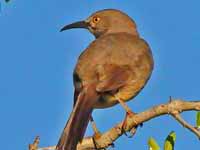

Thrasher,_Gray Toxostoma cinereum Found: Baja California peninsula in Mexico
The Gray Thrasher has gray-brown upperparts; white underparts with arrow-shaped black spost; yellow eyes. It lives in desert scrubland.
Image by: 1) Ron Knight 2) Roberto Gonzalez 3) Blake_Matheson 4) Dick_Culbert


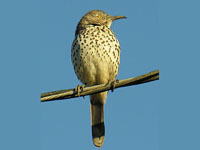
Thrasher_ Le_Conte's Toxostoma lecontei Found: southwest USA, northwest Mexico
The Le Conte's Thrasher has pale sandy-gray upperparts; gray-brown ears, lores; pale whitish throat; pale puffy gray underparts; black sickle-shaped bill; chestnut-brown eyes.
Similar to: California Thrasher, Crissal Thrasher. Le Conte's Thrasher is the palest of all thrashers. It is yellowish-brown under the tail. It is found in open desert areas while the other 2 thrashers are secretive and and like brushy areas.
Image by:
1) Spencer F. Baird 2, 3) Bill Bouton - California 4) Dick Daniels - Arizona 5) Tony_Morris - CaliforniaSimilar to: California Thrasher, Crissal Thrasher. Le Conte's Thrasher is the palest of all thrashers. It is yellowish-brown under the tail. It is found in open desert areas while the other 2 thrashers are secretive and and like brushy areas.



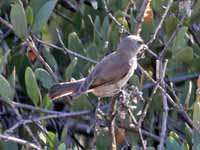

Thrasher,_Long-billed Toxostoma longirostre Found: Texas, Mexico
The Long-billed Thrasher has reddish-brown upperparts; whitish underparts with dark streaks formed from oval shapes.
Similar to: Brown Thrasher. Brown Thrasher is bright reddish-brown above with thin, dark streaks on its buffy underparts. Long-billed Thrasher is brown above with heavy black streaks its white underparts.
Image by: 1) Mark Watson - Texas 2) Alan Wilson 3) Andy_Morffew - Texas 4) Kati_Fleming Similar to: Brown Thrasher. Brown Thrasher is bright reddish-brown above with thin, dark streaks on its buffy underparts. Long-billed Thrasher is brown above with heavy black streaks its white underparts.

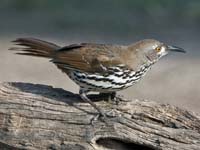
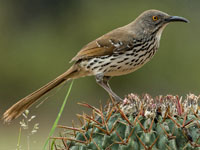

Thrasher,_Ocellated Toxostoma ocellatum Found: south-central Mexico
The Ocellated Thrasher has dark brown upperparts; faint supercilium; white throat; whitish underparts with black spots.
Image by: 1) Amy McAndrews 2) Dominic Sherony 3) Francesco_Veronesi - Mexico